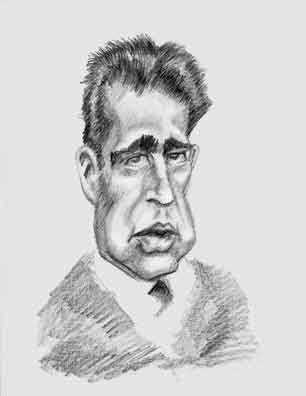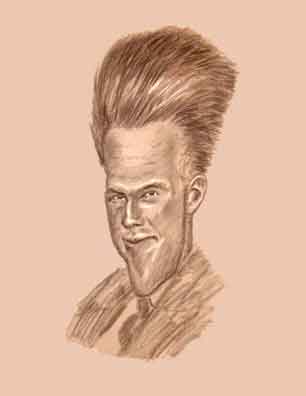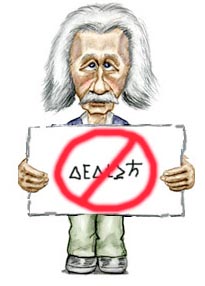Niels Bohr

Niels Bohr
Beer and physics do mix.
Niels Bohr was the first scientist to develop the theory that energy levels of atoms were quantized, that is, the energy was limited to certain discrete values. In Niels' theory the electrons orbited the nucleus much like planets orbit the sun. The distance from the nucleus determined the electrons' energy, but although electrons could go from one energy level to another, they could not have energies in between. So the electrons could change from one orbital to another, it could not travel between then. To change orbit, an electron had to move by - yes - a quantum leap.
Niels' published his theory in 1913, and the energies of the levels were calculated from a very simple formula whose only variable were the integers, 1, 2,3, ..., etc, called the principle quantum numbers. But the formula correctly predicted wavelengths of the emission and adsorption spectrum of the hydrogen atom.
The theory had its limitations, the most problematic was that the atom's structure was unstable. Although the theory required the electrons to orbit the nucleus at a specific distance, in reality a negative particle orbiting a positive center would spiral inward. Still Niels theory was a major breakthrough in explaining atomic and subatomic spectra, and in 1922, Niels picked up a Nobel Prize for his effort. It wasn't until four years later that Erwin Schrodinger and Werner Heisenberg independently discovered quantum mechanics and ushered in the modern scientific era.
By 1922 Niels was one of the most important scientists in the world and a year earlier had established the Institute for Theoretical Physics at the University of Copenhagen where he had been a professor since 1914. Still going strong as the Niels Bohr Institute, the center attracted among the biggest names (and future biggest names) in science.
In those days, theoretical physics was probably the least costly scientific endeavor and the physicists got along fine with just pencil and paper, thank you. Still, the scientists had to eat and any research institute had to have some way to pay the visiting scientists. Costs of research in the day before big science became Big Science was usually met from university funds. Such monies were generally limited and some academics, many of whom came from the leisure class, made do with family inheritances (when J. Willard Gibbs first became professor at Yale he received no salary). So what a research institute needed, then as now, was for some rich fat cat to leave an endowment which could be invested and the interest used to provide a continuous supply of fellowships. In Niels' case his benefactor was the nearby Carlsberg brewery.
Carlsberg was the first brewery to put beer making on a firm scientific basis, and it even had its own research laboratory. The company's owner also realized he had the wherewithal to promote the progress of science in Denmark, and he designated that some of the brewery's profits would be used to promote scientific research. So once Niels got his institute established, many of the early discoveries of quantum theory went to Carlsberg followships. In fact, Werner was working at the institute when he discovered his famous uncertainty principle, which perhaps should be called the Carlsberg principle. To show their appreciation to their benefactor, the physicists working with Niels had ties displaying the Carlsberg bottle which they would wear at the appropriate occasions.

Werner Heisenberg
The "Carlsberg" Princple?
As long as you had proper scientific expertise, it did not take a long and arduous stint at proposal writing to get into Niels' institute. George Gamow had been studying abroad at the University of Gottigen after receiving his Ph. D. from Leningrad. When his money ran out he decided to spend his last day in Europe by visiting Niels. He dropped in unannounced but Niels always had time to speak with a fellow scientist. After talking about George's discoveries in nuclear transformations, Niels asked George how long he was staying. George replied he only had enough money for one day and was returning to Russia. Niels then asked if he could arrange a Carlsberg fellowship, could George could stay a year. Naturally George replied he could. He ended up staying for three. His time at Copenhagen was particularly fruitful as he discovered that radioactive decay of nuclei was due to the quantum phenomenon of tunneling.
Unlike the high pressure 24/7 science practiced today at the major research universities (which has occasionally led students to mayhem and riot), working with Niels - as George said - was easy and relaxed. You showed up when you wanted, worked as long as you liked, and went home when you pleased. There were skiing vacations, football games, and dinners and lunches always with plenty of Carlsberg to go with the main courses.
It's not surprising that Niels was one of the scientists that everyone loved. He had a genial personality with an easy going sense of humor that went from the quirky to wisely profound. He kept a horseshoe hanging above the door of his country home in Tisvile. Once a visitor saw it and asked, "Being as great a scientist as you are, do you really believe that a horseshoe above the entrance to a home can bring luck?"
"No," replied Niels decisively, "I certainly do not believe that superstition."
"But," he added, "they say it does brings luck even if you don't believe in it."
Niels and his students often worked late into the night - the best time for theoretical physicists, said George - and sometimes Niels would say he was tired and wanted to go to the movies. Like many moviegoers of the time, Niels preferred Westerns. But although Niels had no problems with understanding the intricacies of atomic or nuclear physics, the story line of the Hollywood horse opera often baffled him. So when he went to a show, it was inevitable that a couple of students came along along to explain the complexities of the plot with their complicated supply of good guys, bad guys, friendly Indians, hostile Indians, sheriffs, miners, and barmaids.
There was plenty of fodder in the action, though, to occupy Niels' scientific mind He worked out a theory as to why the good guy never draws first but always wins a shootout. The outlaw, he said, had to decide when or whether to draw, and hisindecision impeded his actions. The hero, though, on seeing the outlaw's hand move, responds simply with a conditioned reflex. Therefore he always wins the draw. George and the other students disagreed. So the next day George went out, bought two toy guns, and took them in to work. Niels took the role of the good guy and in quick draw contests beat all his "outlaw" students.
The individual scenes of the films also stretched the bounds of what Niels' literal mind could accept. After seeing one film he remarked, "I can believe that a girl alone might be walking on a narrow trail somewhere in the Rockies and might lose her step, and rolling down to the precipice manage to grab a tiny pine at the brink and so save herself from inevitable death. I can also imagine that, just at that time, a handsome cowboy might be riding the same trail, and noticing the accident, tie his lasso the his horse's saddle and descend into the precipice to save the girl. But it looks to me extremely improbable that at the same time a cameraman would be present to record this exciting event on film!"

Albert Einstein
Telling God What To Do?
When Germany invaded Denmark in 1940, Niels remained in Copenhagen and was a thorn in the side of the occupying administration as he refused to dismiss Jewish students or faculty members. Inevitably the Germans ordered his arrest but in 1943, he was able to escape to Sweden and then to England. He later went to America as a consultant on the Manhattan Project. On the train ride to New Mexico, the military director of the project, General Leslie Groves, spent the entire trip telling Niels the type of information he should not divulge during his talks and seminars even in such a top secret facility. Of course, when they got to Los Alamos Niels began his first presentation saying, "I know General Groves does not want me to say this ...." leaving the general to fume in uncharacteristic silence.
When the theory of quantum mechanics was published by Werner and Erwin, Niels accepted the probabilistic interpretation as had been suggested by Max Born. So Niels found himself in an intense, but respectful, dispute with Albert Einstein, who alone of all major scientists of the time did not accept quantum mechanics. Albert did not think it was wrong per se, but that it was incomplete. He particularly abhorred the idea that the laws of physics were essentially probability at the atomic and subatomic level.
"God does not play dice with the universe," was Albert's well known admonition. Niels suggested that perhaps Albert shouldn't be trying to tell God what to do.
References
Thirty Years That Shook Physics: The Story of Quantum Theory, George Gamow, Doubleday (1966). A classic in the history of science.
American Prometheus: The Triumph and tragedy of J. Robert Oppenheimer, Kai Bird and Martin J. Sherwin, Knopf (2006). This has the story of General Groves and Niels.